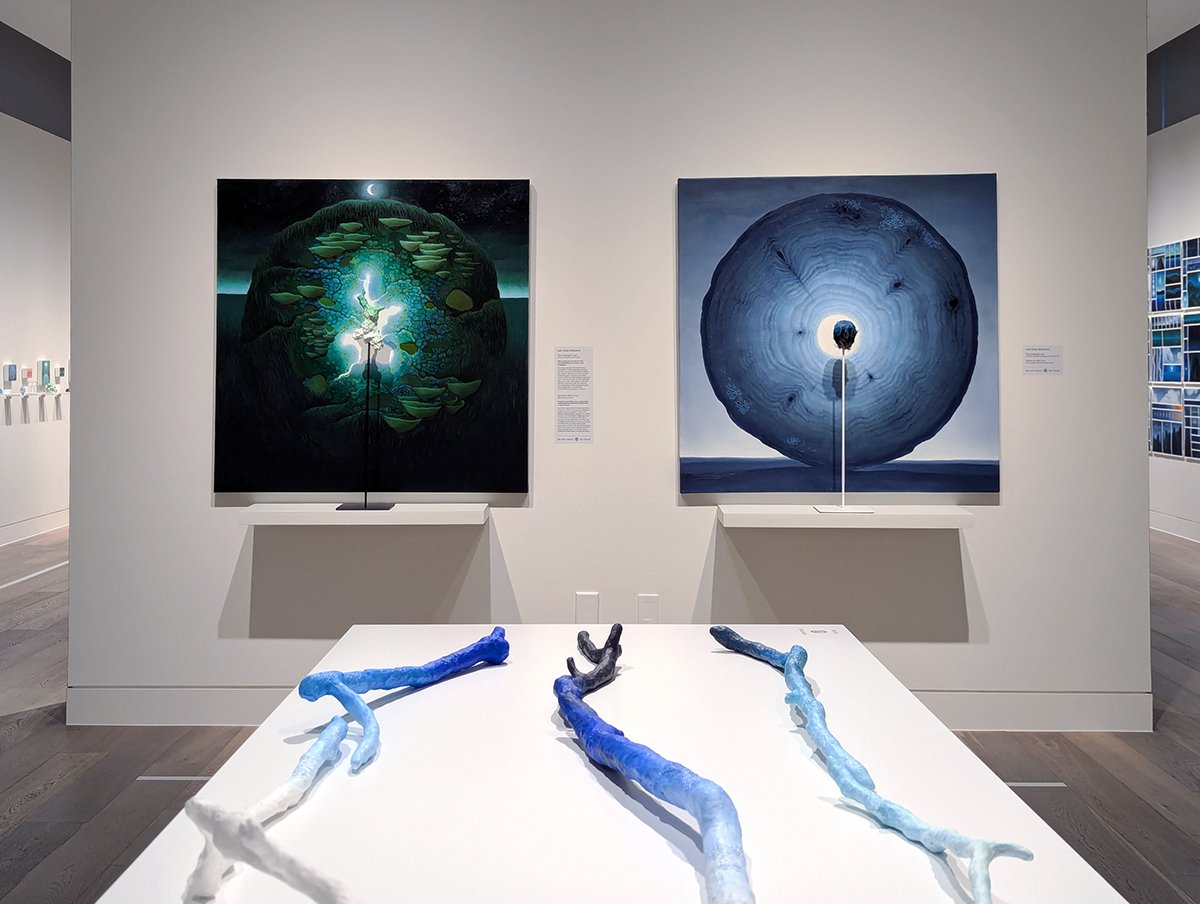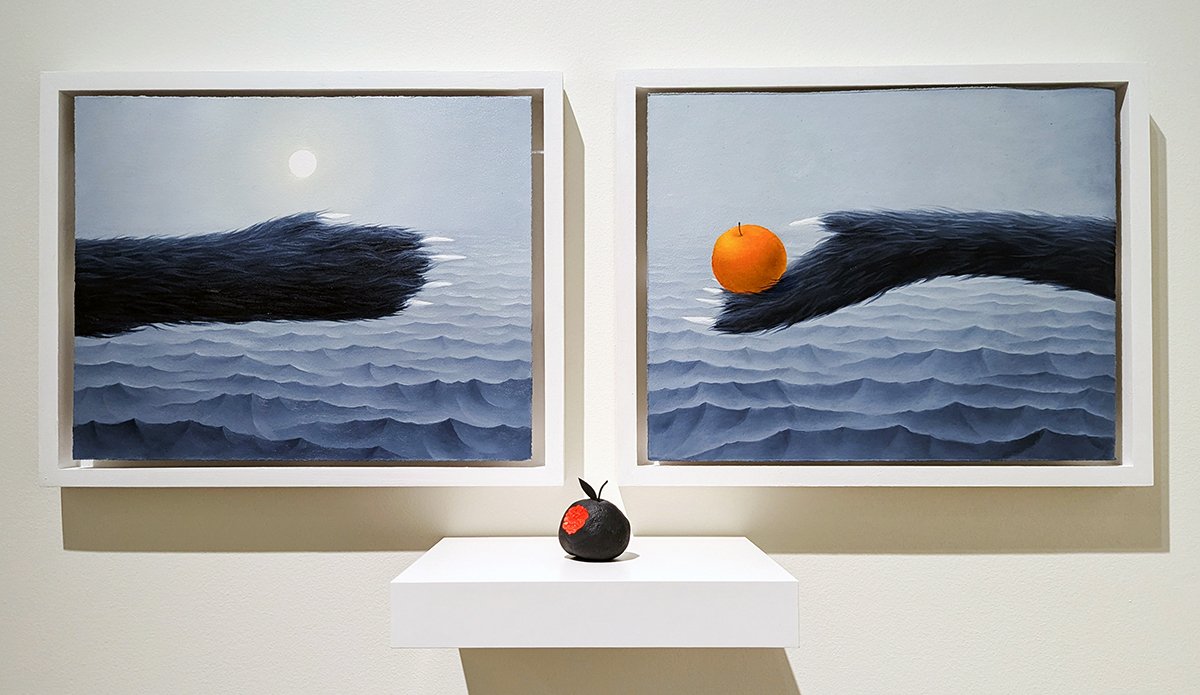Language Without Words
Ash Eliza Williams: Language Without Words
Denver Botanic Gardens Freyer-Newman Center
1007 York Street, Denver, CO 80206
December 22, 2024–May 4, 2025
Admission: adults: $15.75, seniors, military, and veterans: $12; children ages 2-15 and students: $11.50, children ages 2 and under and members: Free
Review by Raymundo Muñoz
Through combinations of words and morphemes, human language allows for countless complex thoughts and expressions, yet so much can still be expressed without them. Nature, of course, has myriad ingenious ways of relaying messages between organisms (e.g. bee dances, chemical signaling between plants, and bright colors as warning signs to predators), but what about the rest? What about the landscape itself, the rocks, and bodies of water? What about the weather and celestial objects that are so far away from us and yet affect everything on earth?
An installation view of Ash Eliza Williams’s exhibition Language Without Words. Image by Scott Dressel-Martin, courtesy of the Denver Botanic Gardens.
In Language Without Words, on view at the Denver Botanic Gardens (DBG) Freyer-Newman Center, Ash Eliza Williams’s stunning paintings and sculptures invite viewers to consider the varied nonverbal ways that nature uses to communicate. Both imaginative and scientifically grounded, Williams offers a surreal and animistic perspective that is visually wonderful, somewhat alien, and subtly spiritual.
Ash Eliza Williams, Shoal (Collective Intelligence), 2024, oil paint on paper, clay, and gouache, 24 x 120 inches. Image by Raymundo Muñoz.
Driven by the artist’s curiosity about the natural sciences, there is a strong educational element to the exhibition. Placed throughout the gallery are curatorial statements related to specific artworks that offer insights into how different organisms communicate. In Shoal (Collective Intelligence), for instance, a school of fish swims in one direction, perpendicular to aquatic plants rising from the water’s edge. It’s a graphically striking piece made more intriguing by the added side statement regarding synchronization via pressure-sensitive sensory organs.
Ash Eliza Williams, Plant and Snake, 2023, oil paint on paper, clay, acrylic paint, and glass, painting: 24 x 12 x 2 inches; sculpture: 1 x 1 x 1 inches. Image by Raymundo Muñoz.
Williams often presents subjects as if they are specimens as well (consider Plant and Snake), floating singularly, centrally, and symmetrically in their paintings (albeit against beautifully hued horizons, not boring neutral backgrounds).
Left: Ash Eliza Williams, Dreams of a Violet-Eared Waxbill, 2024, oil paint on paper, 44 x 60 x 1 inches. Right: Ash Eliza Williams, Dreams of an Orange Fruit Dove, 2024, oil paint on paper, 44 x 60 x 1 inches. Image by Raymundo Muñoz.
A detail view of Ash Eliza Williams’s Dreams of an Orange Fruit Dove, 2024, oil paint on paper, 44 x 60 x 1 inches. Image by Raymundo Muñoz.
Some works (for instance, Dreams of an Orange Fruit Dove and Dreams of a Violet-Eared Waxbill) contain handwritten notes that might be at home in a scientific field journal (such as taxonomical references, colors specific to juvenile species, and areas of habitation).
Ash Eliza Williams, Coral and Geode, 2024, oil paint on paper, clay, and acrylic paint, painting: 24 x 12 x 2 inches; sculpture: 6 x 4 x 2 inches. Image by Raymundo Muñoz.
The small sculptures in the show remind me of plastic anatomical models with clear delineations of color, detail, and texture (see: Coral and Geode). Indeed, many of the works are richly and precisely detailed (for instance, the sheen of light on the leaves in Dreams of a Violet-Eared Waxbill) and could work as botanical illustrations, in theory. As such, the exhibition is a natural fit for the DBG’s mission to connect people with plants. However, Language Without Words doesn’t necessarily read like something at a nature and science museum; there’s something more personal and nuanced on display.
Ash Eliza Williams, Bird Language, 2024, oil paint on paper, clay, gouache paint, and mirror, painting diptych: 30 x 24 x 1.5 inches; sculptures: 1 x 1 inches. Image by Raymundo Muñoz.
Interestingly, Williams gives nearly equal credence to representations of reality and fancy. Some scenes appear as nicely rendered and skillfully stylized landscapes with a strong foot in pure observation (e.g. bird swarms among fluffy clouds in Bird Language).
Ash Eliza Williams, left: Tree Language III; right: Tree Language, both 2024, oil paint on paper, clay, and acrylic paint, paintings: 48 x 48 x 2 inches; sculptures: 8 x 10 x 3 inches. Image by Raymundo Muñoz.
Others are decidedly surreal, like the absolute stunners Tree Language and Tree Language II with their brightly glowing tree cores.
Ash Eliza Williams, Night Feast, 2024, oil paint on paper, clay, acrylic paint, and gouache, paintings: 16 x 42 x 2 inches; sculpture: 3 x 3 x 3 inches. Image by Raymundo Muñoz.
Or consider the alluring yet childlike Night Feast, in which one bear’s clawed paw offers another a bright-colored orange against a softly fading backdrop of cresting waves. It’s a satisfying contrast of color, tone, and intention that’s somewhat dark yet playful.
Ash Eliza Williams, Squid and Sun, 2023, oil paint on paper, clay, and acrylic paint, painting: 24 x 12 x 2 inches; sculpture: 4 x 4 x 4 inches. Image by Raymundo Muñoz.
Further, while some creatures Williams refers to are indeed real (the Orange Fruit Dove, for instance), others seem conjured from imagination (like Squid and Sun). It’s these surreal considerations that suggest some nocturnal world-building—that is, nature dreaming.
Ash Eliza Williams, Dreams of an Orange Fruit Dove, 2024, oil paint on paper, 44 x 60 x 1 inches. Image by Raymundo Muñoz.
Williams makes numerous references to dreaming (and more broadly one’s inner space), with varying degrees of subtlety. Split geodes reveal their chromatic centers, mysterious pools of water reflect dim skies, and stones lie submerged. Eyes open and close in Dreams of an Orange Fruit Dove.
Ash Eliza Williams, Dreams of a Violet-Eared Waxbill, 2024, oil paint on paper, 44 x 60 x 1 inches. Image by Raymundo Muñoz.
Of note, in Dreams of a Violet-Eared Waxbill, a multi-panel collection of oil paintings features montages of events and objects relevant to a specific kind of bird. Based on the distinct orange and violet colors of the bird’s brilliant plumage, the insects, sunsets, volcanoes, feathers, leaves, and celestial events combine in a visual and arresting symphony, driven by the pulsing circadian beats of the rising and setting sun. It’s the idea of birds dreaming, though, the idea that they too experience visions while they sleep—it’s utterly beautiful, endearing, and unifying (with humanity’s own experience).
An installation view of Ash Eliza Williams’s exhibition Language Without Words with Alphabet of Stones in the foreground. Image by Raymundo Muñoz.
The entire exhibition comes across as a gorgeous, calming dream, washing over you with its epic and pensive landscapes that feel like somewhere and nowhere, familiar yet alien. The sense of quiet atmosphere, all the lush contrasts of dark and light expressed through deep and sensitive gradations of color and tone, and the way that so many objects glow and float imbues the works with a sense of spirituality—not in a religious way, rather more primal. This all suggests a much deeper message, though you may have to pick up a rock or two to find it.
Ash Eliza Williams, Alphabet of Stones (Lithic Language), 2024, clay, acrylic paint, and gouache paint, each sculpture: 2–7 inches tall and 4 inches in diameter. Image by Raymundo Muñoz.
In Alphabet of Stones (Lithic Language)—a tactile offering—visitors are invited to explore a succession of sculptures of rocks inspired by the fossil record. (It’s satisfying trying to find the perfect spots for your fingers to fit and feel!). Raising the painted clay stones reveals a surprise beneath them and seems to imply that there's a hidden meaning to things if you investigate beyond the surface. What countless geologic stories over hundreds of millions of years are told through the rock strata alone?
A view of works by Ash Eliza Williams in the exhibition Language Without Words. Image by Scott Dressel-Martin, courtesy of the Denver Botanic Gardens.
The passage of time seems to be a central element in all of the wordless languages Williams explores. Sun and moon cycles, the changing light values and colors upon landscapes throughout the day, the nibbled evidence of insects on vegetation, and the coming and going of storms. These images appear repeatedly along with references to order and chaos (such as birds spontaneously swarming into tight elliptical shapes), suggesting commonalities and complexities to what nature regards and conveys the most.
Ash Eliza Williams, Bird Language (Murmuration), 2024, oil paint on paper, 70 x 90 inches. Image by Raymundo Muñoz.
One critical point: it’s hard to say, but there’s probably too much work. For such a beautiful collection, sections of it come off a little cramped. Also, arguably one of the best pieces, Bird Language (Murmuration), is located in front of an entrance, when functionally it might have lived better on the title wall in the room’s center. If considered in terms of nature’s density, this all might be fine, but it tends to diminish one’s connection to the immense spaces depicted. And you really want to get lost in these works.
Ash Eliza Williams, The Couple (Conversation in Light), 2024, oil paint on paper, lower diptych: 24 x 30 x 2 inches. Image by Raymundo Muñoz.
Language Without Words is about finding ways to connect. Despite our different experiences and ways of communicating, there are shared symbols and cycles that have existed and will exist long after we’re gone, tying together the intimate biodynamism of earth with the vast and mysterious cosmos. Perhaps we all grapple with an inherent loneliness, wandering life’s dark wilderness to find other beings and processes we can couple with (consider the jellyfish love fest of The Couple (Conversation in Light)). And that’s what makes language in any form so vital to our continued existence.
Ash Eliza Williams, Tree Language II, 2024, oil paint on paper, clay, and acrylic paint, paintings: 48 x 48 x 2 inches; sculptures: 8 x 10 x 3 inches. Image by Raymundo Muñoz.
As a self-confessed shy kid, Williams dreamt about communicating nonverbally via bioluminescence and fungal networks. Considering this, there seems to me an implied challenge to Language Without Words: be quiet. Observe, listen, touch, and witness the thoughts and feelings that arise in you. Nature speaks constantly, and has much to say, but may be in no rush to say it. Learning its languages takes time, patience, and an openness to see the world through different eyes.
Raymundo Muñoz (he/him) is a Denver-based printmaker and photographer. He is the director/co-curator of Alto Gallery and board president of the 501(c)(3) non-profit Birdseed Collective. Ray is guided by the principle that art is a bridge, and it connects us to ourselves and each other across time and space.

























